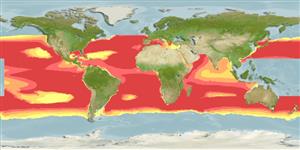Preferred temperature (Ref.
123201): 4.1 - 13.9, mean 8.5 °C (based on 878 cells).
Phylogenetic diversity index (Ref.
82804): PD
50 = 0.5312 [Uniqueness, from 0.5 = low to 2.0 = high].
Bayesian length-weight: a=0.00955 (0.00400 - 0.02282), b=3.06 (2.85 - 3.27), in cm total length, based on LWR estimates for this (Sub)family-body shape (Ref.
93245).
Trophic level (Ref.
69278): 3.1 ±0.20 se; based on food items.
Widerstandsfähigkeit (Ref.
120179): hoch, Verdopplung der Population dauert weniger als 15 Monate. (tmax=1).
Fishing Vulnerability (Ref.
59153): Low vulnerability (10 of 100).
Nutrients (Ref.
124155): Calcium = 236 [74, 1,586] mg/100g; Iron = 3 [1, 12] mg/100g; Protein = 3.75 [0.00, 7.87] %; Omega3 = 0.346 [0.089, 1.339] g/100g; Selenium = 36.7 [7.8, 217.8] μg/100g; VitaminA = 33 [4, 280] μg/100g; Zinc = 2.65 [1.07, 7.29] mg/100g (wet weight);
